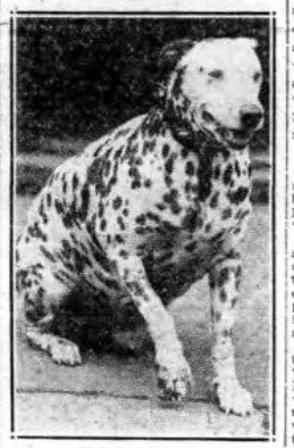
“Jiggs was the dog who started out as a lithe, slim pup who ran yelping and barking just ahead of the three beautiful horses that pulled old “205.” But Jiggs fell into evil ways. He became a connoisseur of Borough Hall restaurant kitchens. A gourmet.
“Things came to such a pass that Jiggs fell down on his job of leading the fire engine. He grew to the proportions of a Shetland pony . . .” –Brooklyn Standard Union, 1929, article about the fire dog of Engine Company 205
When 8-year-old Jiggs died on September 14, 1925, he was called “Brooklyn’s fattest dog” in his “obituary” in The Brooklyn Standard Union. You see, Jiggs had a bad habit of making the daily rounds at the Brooklyn Borough Hall restaurants, and when he died, he tipped the scales at 121 pounds.
It wasn’t his weight, though, that killed him. Jiggs was “humanely dispatched” by the Brooklyn SPCA because he had reportedly become a grumpy old man in his final year of retirement.
A St. Patrick’s Day Puppy
Jiggs was born on March 17, 1917, and presented to Engine Company 205 in Brooklyn Heights on Memorial Day of that year. Right away, he bonded with 39-year-old Engineer Thomas J. “Smoke” McEwan. Over the years, he rarely left his side.

Jiggs also took a liking to Bum and her kittens. Bum was a Brooklyn aristocrat and the long-time mascot cat of Engine Company 205. Her mother had been found cold and starving on the street near the firehouse on Pierrepont Street in 1909. Bum and all her siblings stayed in the neighborhood, but only Bum was lucky enough to get a permanent home at the fire station.
Jiggs was quite hyperactive in his youth, and would bark and jump around like crazy whenever the gong rang for a fire. Bath time was also a struggle for Smoke and fireman Frank Wolf, but somehow they managed to bathe Jiggs four times a week.
Sometimes young Jiggs would get a little too friendly or too ambitious. Once he tried to make friends with one of the horses and got booted through a rear window. Another time he broke his leg while trying to slide down the pole.
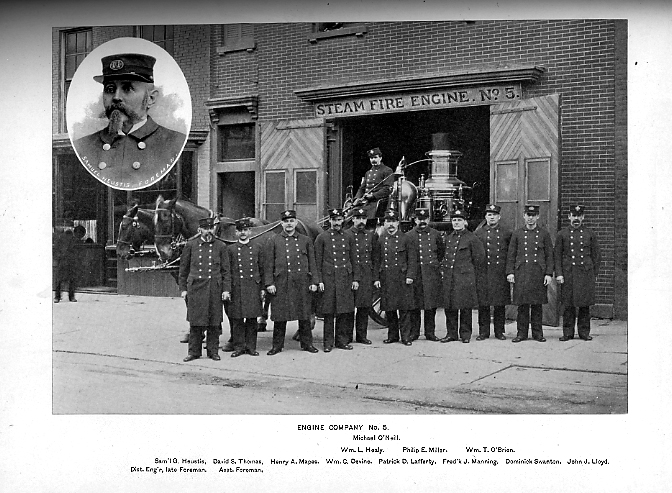
Jiggs Meets Chef Martin
During those first few years as a fire buff, Jiggs never weighed more than 71 pounds. He was fast with the horses and always present on every call, no matter the size of the fire or incident. In his first five years of service, he reportedly responded to more than 10,000 fire calls.
But then he struck up a friendship with John Martin, a chef in Joe’s Restaurant at the corner of Fulton and Pierrepont streets. John couldn’t help but give the dog a few treats every day, and with a menu that listed over 400 food choices, there was plenty to go around for Jiggs.
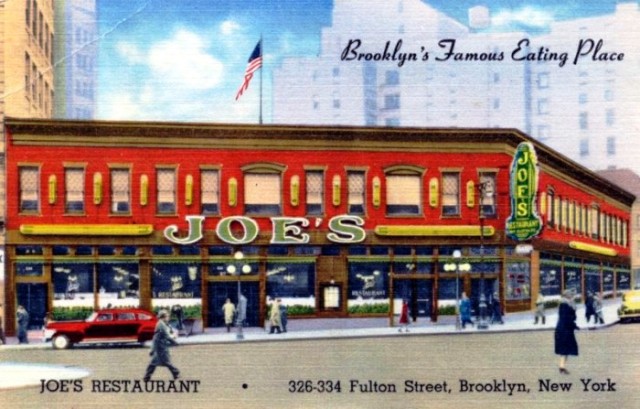
After meeting John Martin, Jiggs discovered other friendly chefs at nearby restaurants. Chefs encouraged the dog to eat and often bragged about the fact that the famous fire dog preferred his restaurant kitchen to another.

No Diet and No Exercise
Fire dogs are tough but they have three enemies: accidents, colds and overweight. The last is the worst. Now that the days of running to fires with the horses are gone they need to watch their figures, and they have too many kind friends. — New York Sun, December 7, 1940
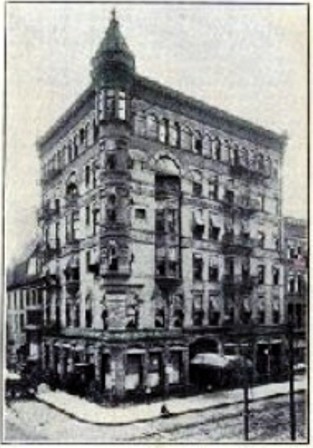
Jiggs couldn’t have become a canine epicurean at the worst time in the history of the New York Fire Department. Only 11 years before, Commissioner Rhinelander Waldo proposed motor-driven fire apparatus for the FDNY.
One by one, each company replaced its horses with motorized apparatus. Brooklyn’s Engine 205 was the last to relinquish its horses in 1922.
With the horses gone, Jiggs could no longer get his daily exercise. Refusing to be pensioned off and sent to a retirement farm, Jiggs tried running with the motorized apparatus a few times, but it nearly killed him. An overweight Dalmatian was no match for a motorized engine that could go 30 to 40 miles an hour.
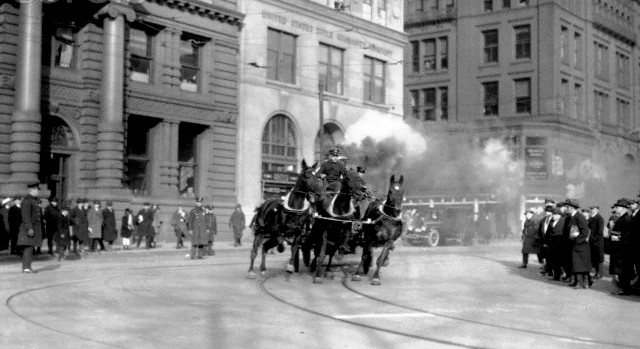
By 1923, Jiggs weighed 118 pounds. Twice the firemen sent him to an exclusive farm for canine reduction treatments, but both times he made his way back to Pierrepont Street. Then on October 12, 1923, Jiggs was taken to the Ellin Prince Speyer Free Hospital for Animals at 350 Lafayette Street in Manhattan to be treated for painful swelling in his right paw, which turned out to be gout.
Jiggs was reportedly put on a strict diet and did lose some weight over the next two months. But before long, when Smoke McEwan wasn’t watching him very carefully, Jiggs got back into his bad ways and was soon as heavy as ever.
By the summer of 1925, Jiggs was reportedly “fatter and lazier than ever.” He spent his days laying outside the firehouse sunning himself, and, as the firemen said, never partook in “any feminine activities such as dieting to reduce.” Captain Leon Howard told the press that the men never fed Jiggs – he fed himself – and that the fatter he got, the more he found to eat.
In July 1925, Engine Company 205 was relocated to 274 Hicks Street. For Jiggs, Hicks Street was a long way from Borough Hall and all his favorite restaurants. Unable to adjust to the change, what Smoke once called “the best natured dog in the world” soon grew remorse and ill tempered.
That month, Jiggs nipped at a passerby who had reportedly kicked him in the paw. The man, 38-year-old Alexander Kyle of 78 Kingston Avenue, was treated at Long Island Hospital for a bite on the right leg. Jiggs was transferred to the pound in a wagon donated by the Brooklyn Standard Union (the distance was too great for him to walk), were he was detained for 10 days as authorities confirmed that he didn’t have rabies.
Upon his release from the pound, Jiggs was issued a silver-plated muzzle and a dog license. Fire Commissioner Thomas J. Drennan told Captain Howard, “Put him back on active duty. He will neither be fined nor his pay deducted. Jiggs is one of the best dogs in the history of the Fire Department.”
Apparently Jiggs didn’t wear the muzzle, because two months later, the men of Engine Company 205 had to call in the SPCA to “dispatch” their fire dog. He was reportedly snapping at many people, including children, and was a danger to the public. Sadly, Smoke was on vacation at the time, and the men were not able to locate him before Jiggs was put to death.
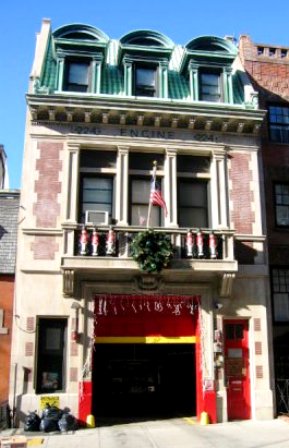
When Jiggs died in 1925, the old Engine Company 205 firehouse on Pierrepont Street died too. For some time, the 1869 building was used as a “parking space” for the mounted police, who would drop their horses off there when they went downtown for lunch or dinner. In the 1940s and 50s, the building served as the headquarters for the Kings County American Legion. Today, there’s a large office building on the site which houses Brooklyn’s Social Security Office.
These days, Engine 205 and Ladder 118 make their home at 74 Middagh Sreet. On September 11, 2001, both companies rushed over the Brooklyn Bridge to get to the World Trade Center. The men of Engine 205 arrived first, but most of their lives were spared when they had to carry the body of a fallen firefighter from another company to an ambulance a block away, out of the immediate danger zone. Sadly, Lt. Robert Walsh and Captain Martin Egan Jr. were also killed.
Lt. Robert Regan, Lt. Joe Agnello, and firefighters Leon Smith, Vernon Cherry, Scott Davidson, and Peter Vega of Ladder 118 were last seen running up the stairs of the Marriott World Trade Center Hotel to help the panicked guests. All six men were killed while trying to save others.
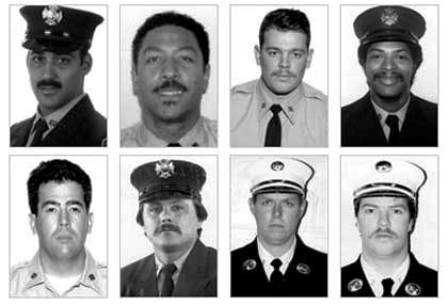
Here is the photograph that captured Ladder 118 speeding across the Brooklyn Bridge toward the flaming towers. I have a feeling that if this photo had been taken 80 years earlier, we’d see a horse-drawn ladder truck with a Dalmatian named Jiggs running alongside.





What timing! Note: Joe’s Restaurant is now Hillary Clinton’s Campaign Headquarters. Always interesting stories
I enjoyed the tale of Jiggs. I betcha that was one happy dog.
Shawn from Laughing at Life 2
Dalmatians are wonderful dogs with a little bit of attitude as they age. Poor Jiggs – nice story
[…] Jiggs, the long-time coach dog and mascot of Engine Company No. 205, howled in sorrow as his horse friends were bid their final farewell. […]